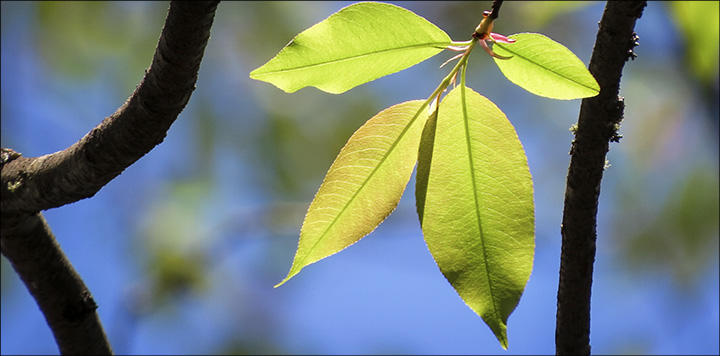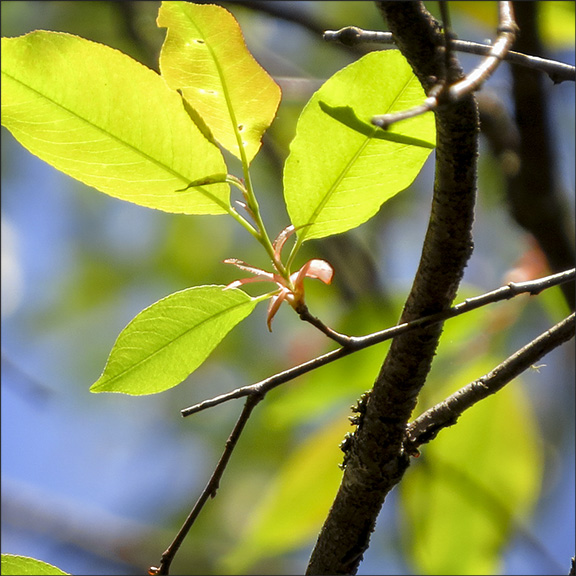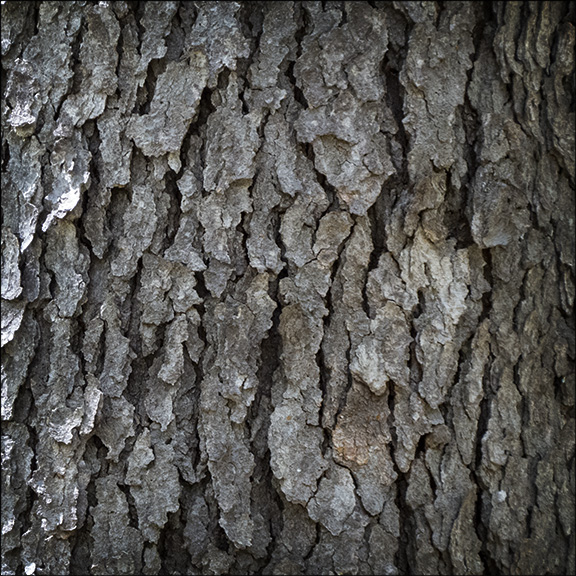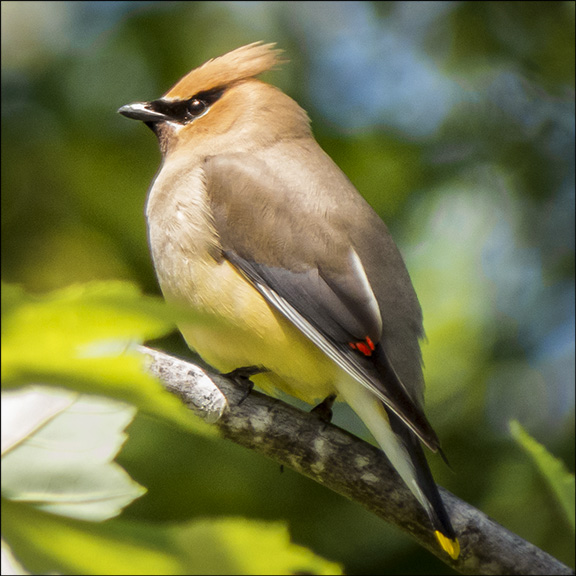Trees of the Adirondacks:
Black Cherry (Prunus serotina)
 Trees of the Adirondacks: Black Cherry leaves are elliptical and finely toothed. Black Cherry on the Jenkins Mountain Trail (17 May 2015)
Trees of the Adirondacks: Black Cherry leaves are elliptical and finely toothed. Black Cherry on the Jenkins Mountain Trail (17 May 2015)
| This page is no longer being updated. For an updated and expanded version of this material, see: Black Cherry (Prunus serotina). |
The Black Cherry (Prunus serotina) is a deciduous tree that grows throughout New York State and the Adirondack Mountains. The largest and most important of the native cherries and the only one of commercial value, the Black Cherry is found throughout the eastern United States. It is a member of the rose family. The common name – Black Cherry – is from the black color of the ripe fruits. The tree is also known as Wild Cherry, Mountain Black Cherry, and Rum Cherry; the latter name is a reference to a time when Appalachian pioneers flavored their rum or brandy with the fruit to make a drink called cherry bounce.

Identification of the Black Cherry: The leaves of the Black Cherry are oblong, with a long pointed tip and a tapering base. The leaves, like the branches, are alternate: they emerge from the stem one at a time. The edges of each leaf are finely toothed; the tiny teeth curve inward. In the spring, the leaves have a pair of brightly-colored stipules (outgrowths on either side of the leaf stalk). Black Cherry leaves are shiny and dark green on the upper surface, light green below. The emerging leaves of the Black Cherry are often reddish. In fall, the leaves turn yellow to orange, then to red late in the season.
Black Cherries flower in late spring, after the leaves emerge. The insect-pollinated flowers are small (3/8") and white, arranged in terminal spikes about five inches long. The edible fruit, which ripens in July and August in the Adirondack Mountains, occurs in dropping clusters. Each fruit is about 1/2" in diameter, with a single round seed. The green cherries turn dark red, then purple-black at maturity during the fall. Black Cherry bark is reddish-brown and smooth when young, with conspicuous, horizontal lines. The bark becomes dark gray and scaly on older trees.

Keys to identifying the Black Cherry and differentiating it from other deciduous trees include its leaves, bark, and growth habit.
- The oval leaves of the Black Cherry contrast sharply with the lobed leaves of Red Maple, Striped Maple, and Sugar Maple, but they are somewhat similar to those of the American Beech, Paper Birch, and Yellow Birch, in that the leaves of all four species are alternate and toothed. However, the leaves of birch trees are double toothed, meaning that the teeth are of different sizes, with small teeth along the contours of larger teeth. Those of both the Black Cherry and American Beech are single toothed, but leaves of the Black Cherry are finely toothed, while those of the American Beech are coarsely toothed.
- The scaly, dark bark of the mature Black Cherry is very different from that of the smooth, gray bark of the mature American Beech or the peeling bark of the Paper Birch and Yellow Birch. The tightly-packed scales have out-turned edges. If you break off one of the scales, you will find bright orange-brown underbark. The bark of a mature Black Cherry tree is said to resemble burnt corn flakes – (Black Cherry/Burnt Cornflakes).
- The crushed foliage and bark of Black Cherries have a distinctive cherry-like odor.
- The growth habit of the Black Cherry differentiates it from the Pin Cherry. Pin Cherries are smaller trees, rarely reaching 30 or 40 feet high. In addition, Pin Cherry leaves are longer and narrower than those of Black Cherry.
Uses of the Black Cherry: The hard, reddish wood of the Black Cherry is highly valued for furniture. It works well and takes polish well. The wood is also used for paneling, professional and scientific instruments, handles, and toys. The fruit is used for making jelly and wine and can also be used as a seasoning. However, any bitter fruit can be toxic and should not be eaten. Moreover, the twigs and leaves of the Black Cherry contain high levels of hydrocyanic or prussic acid; the foliage is toxic to both humans and livestock. The seeds as well contain high quantities of hydrogen cyanide and should not be eaten.
The Black Cherry was used by various native American tribes to treat a variety of ailments, including coughs, colds, ulcers, fevers, measles, and burns. The Cherokee, for instance, reportedly created a decoction of inner bark which was used for laryngitis. The Chippewa applied a poultice of the inner bark to cuts and wounds. The Delaware are said to have made a cough syrup from the fruit. Black Cherry is little, if at all, used in modern herbalism.

Wildlife Value of the Black Cherry: Wild cherries, including the Black Cherry, are among the most important wildlife food plants. Red Foxes, Eastern Chipmunks, Cottontails, White-footed Mice, and red, gray and fox squirrels forage on fallen cherries, while Black Bears and raccoons climb Black Cherry trees for the fruits. During winter, voles feed on the bark at snow level. White-tailed Deer and Moose, which are not sensitive to the toxins, browse on the twigs and foliage in the fall and winter. These animals spread the seeds to new areas.
Many insects use the Black Cherry as a source of food, particularly the leaves. The nectar and pollen of the flowers attract honeybees and bumblebees. The Black Cherry is a caterpillar host of many butterflies and moths, including Small-eyed Sphinx, New England Buckmoth, Canadian Tiger Swallowtail, Scalloped Sallow, and Dowdy Pinion.
Black Cherries are part of the deciduous forest that provides the breeding range for many bird species, including Hooded Warbler, Mourning Warbler, Wild Turkey, and Northern Saw-whet Owl. Fruits from Black Cherry trees make up part of the diet of many birds, including: Wood Duck, Northern Flicker, Wood Thrush, Cedar Waxwing, and American Crow.
Distribution of the Black Cherry: Black Cherry grows in eastern North America from western Minnesota south to eastern Texas, and eastward to the Atlantic from central Florida to Nova Scotia. Black Cherry is a shade-intolerant species that usually occurs as scattered individuals in various types of mesic woods and second-growth hardwood forests, as well as in old fields and along fence rows. In the Adirondacks of upstate New York, Black Cherries are rather uncommon in the mountainous portions of the high peak region, but can be seen in late successional forests at lower elevations.
Black Cherry at the Paul Smiths VIC: Black Cherries at the VIC do not grow in stands, but as individual trees in deciduous or mixed forest. Look for a very large Black Cherry tree on the west side of the Heron Marsh Trail, near signpost #14, between the board walk and the floating bridge. There are also a few Black Cherries on the Jenkins Mountain Trail, between the intersection with the Barnum Brook Trail and the intersection with the Heron Marsh Trail. Look for a Black Cherry tree on the Barnum Brook Trail, just after the fish barrier dam when walking in a clockwise direction.
References
- United States Department of Agriculture. Forest Service. Silvics of North America. Black Cherry. Retrieved 11 April 2016.
- United States Department of Agriculture. Plants Database. Retrieved 11 April 2016.
- Lady Bird Johnson Wildflower Center. Native Plant Database. Retrieved 11 April 2016.
- University of Wisconsin. Trees of Wisconsin. Prunus serotina. Retrieved 11 April 2016.
- Online Encyclopedia of Life. Prunus serotina. Retrieved 11 April 2016.
- University of Wisconsin. Flora of Wisconsin. Retrieved 11 April 2016.
- New York Flora Association. New York Flora Atlas. Retrieved 11 April 2016.
- University of Michigan. Native American Ethnobotany. A Database of Foods, Drugs, Dyes and Fibers of Native American Peoples, Derived from Plants. Retrieved 11 April 2016.
- Plants for a Future. Database. Retrieved 11 April 2016.
- The Birds of North America. Subscription Web Site. Hooded Warbler, Mourning Warbler, Wild Turkey, Northern Saw-whet Owl, Wood Duck, Northern Flicker, Wood Thrush, Cedar Waxwing, American CrowRetrieved 12 April 2016.
- Butterflies and Moths of North America. Retrieved 12 April 2016.
- Ellen Rathbone, "Adirondack Tree Identification 102," The Adirondack Almanack, 18 November 2009. Retrieved 11 April 2016.
- E.H. Ketchledge. Forests and Trees of the Adirondacks High Peaks Region (Lake George, New York: Adirondack Mountain Club, 1996), pp. 126-129.
- Michael Kudish. Adirondack Upland Flora. An Ecological Perspective (Saranac, New York: The Chauncy Press, 1992), pp. 75, 156.
- Michael Wojtech. Bark: A Field Guide to Trees of the Northeast (University Press of New England, 2011), pp. 216-217.
- William K. Chapman and Alan E. Bessette. Trees and Shrubs of the Adirondacks. A FIeld Guide (Utica, New York: North Country Books, Inc., 1990), p. 45, Plate 14.
- Stan Tekiela. Trees of New York. Field Guide. (Cambridge, Minnesota: Adventure Publications, Inc., 2006), pp. 96-97.
- Peter J. Marchand. Nature Guide to the Northern Forest. Exploring the Ecology of the Forests of New York, New Hampshire, Vermont, and Maine (Boston, Massachusetts: Appalachian Mountain Club Books, 2010), p. 81.
- George A. Petrides. A Field Guide to Eastern Trees (Boston: Houghton Mifflin Company, 1998), pp. 104-105, 323-324.
- George A. Petrides. A Field Guide to Trees and Shrubs (Boston: Houghton Mifflin Company, 1958,1972), pp. 13, 236, 340.
- Gil Nelson, Christopher J. Earle, and Richard Spellenberg. Trees of Eastern North America (Princeton : Princeton University Press, 2014), pp. 546-547.
- C. Frank Brockman. Trees of North America (New York: St. Martin's Press), pp. 166-167.
- Keith Rushforth and Charles Hollis. Field Guide to the Trees of North America (Washington, D.C., National Geographic, 2006), p.171.
- National Audubon Society. Field Guide to North American Trees (New York: Alfred A. Knopf, 1980, 1995), Plates 136, 447, 548; pp. 506-507.
- Allen J. Coombes. Trees (New York: Dorling Kindersley, Inc., 1992), p. 269.
- Alexander C. Martin, Herbert S. Zim, and Arnold L. Nelson. A Guide to Wildlife Food Habits (New York: Dover Publications, 1951), pp. 329-331.
- Bruce Kershner, et al. National Wildlife Federation Field Guide to Trees of North America (New York: Sterling Publishing Co., 2008), p.335 .
- John Eastman. The Book of Forest and Thicket. Trees, Shrubs, and Wildflowers of Eastern North America (Harrisburg, Pennsylvania, 1992), pp. 52-55.
- David Allen Sibley. The Sibley Guide to Trees (New York: Alfred A. Knopf, 2009), pp. 264-265.
